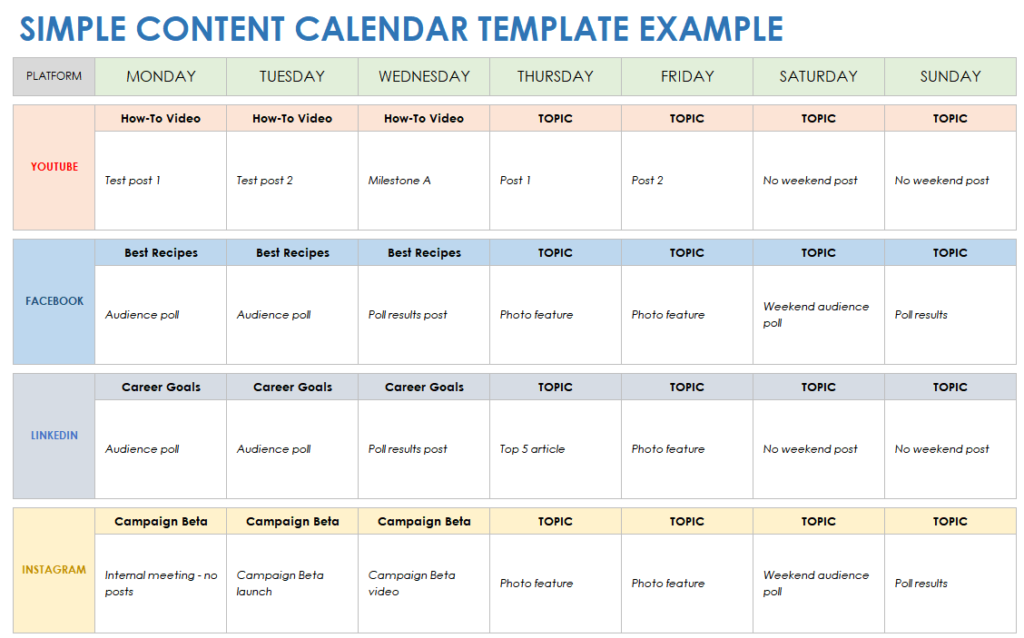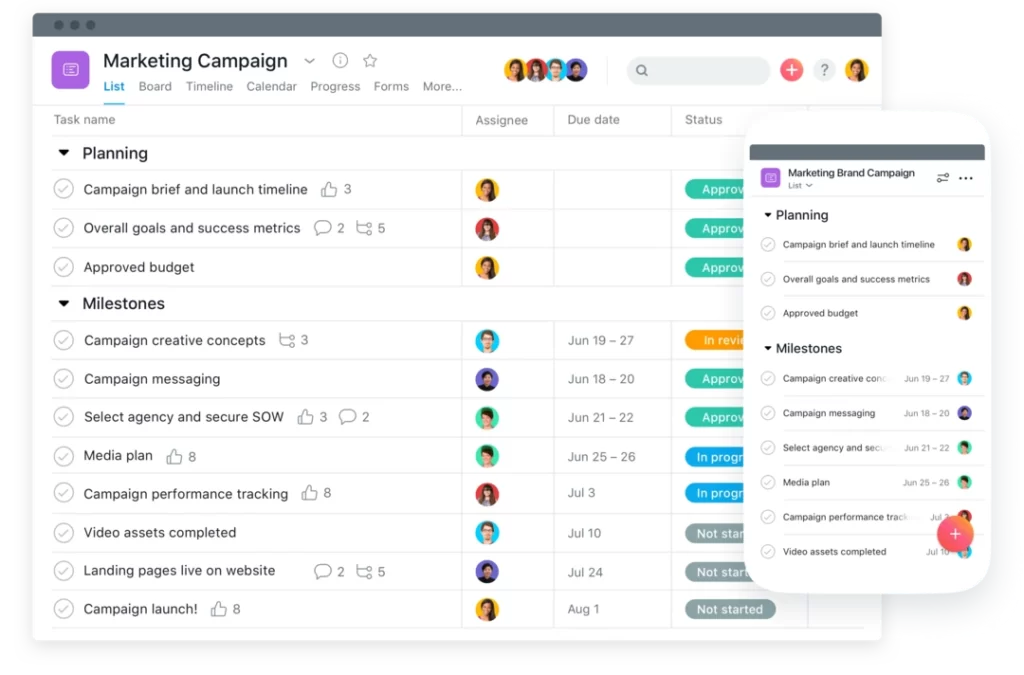Crafting a Winning Content Calendar: The Definitive Guide
If you want your business to thrive in today's digital landscape, having a solid content strategy is essential. And what is the backbone of any successful content strategy? A well-crafted content calendar.
A content calendar allows you to plan and schedule your content marketing efforts in advance. It ensures you create the right content at the right time to attract and engage your target audience.
But with so many different types of content to produce and promote (blog posts, videos, podcasts, eBooks, etc), creating an effective calendar is easier said than done. Where do you even begin?
This comprehensive guide will walk you through the entire content calendar creation process step-by-step. You’ll learn:
- The benefits of using a content calendar
- How to research to inform your calendar
- Tips for mapping out your content types and topics
- How to set an editorial schedule that works
- The best tools for organising and managing your calendar
- How to use your calendar to amplify content promotion
Let’s dive in!
Table of Contents
Why You Need a Content Calendar

Before we get into the nuts and bolts of building your calendar, let’s review the key reasons you need one in the first place:
It Keeps You Organised
A content calendar imposes order on the process of content creation. Rather than just writing sporadically whenever inspiration strikes, you’ll have a clear plan for what to create and when.
This organisation is invaluable in terms of the following:
- Ensuring you have a steady stream of content in the pipeline
- Eliminating the last-minute scramble of figuring out “what should we post next week?”
- Enabling collaboration across teams (everyone knows the plan!)
It Enables Strategic Planning
A calendar allows you to step back and view your content marketing holistically. You can see which topics and formats you’re investing in and which areas need more attention.
With this bird’s eye view, you can make strategic decisions about:
- Which audience segments and topics to focus on
- When to schedule particular evergreen versus timely content
- How to balance content types, formats, and channels over time
It Maximises Impact
The right timing and promotion can make or break a piece of content. A calendar lets you plan optimal timing around events, trends, and audience demand cycles.
You can also use it to coordinate promotion plans and align content pieces for maximum impact.
In short, a calendar helps ensure no content gets lost in the shuffle but, instead, surfaces when and where your audience will respond.
It Facilitates Collaboration
For larger marketing teams, a cohesive calendar is crucial for smooth collaboration.
When everyone is aligned on the content roadmap, it minimises redundant work. It also reduces bandwidth-sapping debates about what to cover and when.
Most importantly, it ensures various content efforts and campaigns complement rather than compete with each other.
It Enables Measurement
How can you determine what’s working content-wise if you don’t even know what you published and when?
A calendar provides an at-a-glance record of your content activities so you can go back and connect the dots.
You can see what topics and formats resonate at different times. And that informs future planning, creating a positive feedback loop.
For all these reasons, taking the time to map out a thoughtful content calendar is worth the effort. Let’s now explore the framework for building yours.
How to Create Your Content Calendar: A Step-By-Step Blueprint

Creating your content calendar is a multi-step process. The high-level phases are:
1. Conduct Research
Begin by thoroughly analysing your existing content and assessing your audience’s interests and needs. This will reveal gaps and opportunities your calendar should address.
2. Map Out Content Types and Topics
Next, brainstorm the formats and subjects you’ll cover based on your goals, resources, and research learnings. Sort these into categories and buckets.
3. Set the Editorial Schedule
Develop a production schedule, mapping out specific topics and content types by week or month. Factor in seasonality, promotions, and trends.
4. Select the Right Tools
Choose tools to help you organise, collaborate on, and manage the execution of your calendar. Enable integrations where helpful.
5. Coordinate Promotion
Finally, build a promotion schedule, planning how and when to amplify each content asset via social media, email, ads, and more.
Let’s explore each step in more detail:
Step 1: Conduct Research
The foundation for an effective content calendar is a keen understanding of your audience and content performance. Take the time upfront to analyse thoroughly:
Your audience personas – Review your key audience segments. Note their interests, pain points, and goals. Identify gaps in how current content is addressing different groups.
Your existing content – Take stock of blog posts, videos, and other content you’ve published over the past 6-12 months—group similar topics and note which seem to resonate best and worst.
Your analytics data – Analyse metrics on past content: social engagement, email click-throughs, pageviews, leads generated, etc. Look at trends over time.
Your competitors – Review competitors’ content calendars and hijack holidays to determine what performs well in your industry. Identify gaps where you can stand out.
Industry trends – Scan industry publications, Google Trends, social media, and other sources to pinpoint emerging trends and topics to cover.
Your business goals – Consider overarching marketing and sales goals that content can help achieve. Identify target metrics to optimise.
Your promotion channels – Factor in how you’ll promote content when determining the correct formats and topics.
Conducting this strategic research will reveal prime topics and formats to invest in more (or less) in your calendar.
- Amazon Kindle Edition
- Pulizzi, Joe (Author)
- English (Publication Language)
- 520 Pages – 03/07/2023 (Publication Date) – McGraw Hill (Publisher)
Step 2: Map Out Content Types and Topics
Armed with your research learnings, it’s time to define the formats and subjects you’ll tackle in your calendar.
Start by listing out all the different content types and formats you have the bandwidth to produce, such as:
- Blog articles
- Videos
- Podcasts
- Webinars
- Ebooks, whitepapers, guides
- Social media posts
- Email newsletters
- Infographics and visual assets
- Quizzes, assessments, calculators
Then, brainstorm specific topics for each format based on your audience, goals, and competitive research.
Next, start grouping topics into themes, campaigns, or seasons. For example:
- Industry guide (evergreen basics)
- Awareness campaign (toxin-free beauty)
- Seasonal content (summer skincare)
Also indicate frequency – daily, weekly, monthly – for ongoing content like social media and newsletters.
This process will generate a master list of formats and subjects to draw from when building your calendar.
Step 3: Set the Editorial Schedule
Now it’s time to map out your calendar week-by-week or month-by-month. There are two key factors to consider here:
1. Content subject and type mix
Aim for a healthy balance across:
- Content formats – Don’t just blog; mix in different media like video.
- Topic themes – Blend evergreen, seasonal, audience-specific, etc.
- Intent – Include a mix of top, mid, and lower-funnel content.
2. Timing
Think about timing in terms of:
- Audience demand cycles – When are fans most engaged?
- Industry events and trends – When are key conferences or product releases?
- Holidays and cultural events – What are relevant hook opportunities?
- Internal promotions – What email/social campaigns are you running?
Factor these elements in as you plug topics and formats into specific weeks and months in your calendar.
Aim to space out key content types appropriately without significant gaps. You want a steady drumbeat of diverse content.
- Hanly, Laura (Author)
- English (Publication Language)
- 144 Pages – 10/02/2016 (Publication Date) – CreateSpace Independent Publishing Platform (Publisher)
Step 4: Select the Right Tools
With your editorial calendar set, implementing it smoothly requires choosing the right tools. Look for solutions that enable:
Centralised calendar view – See all content in one place for easy collaboration and status tracking.
Editorial workflows – Streamline creating, approving, and scheduling content.
Integration with CMS, email, etc. – Automatically flow new calendar items into your publishing platforms.
Analytics integration – Bring in metrics for assessing performance.
Calendaring and scheduling – Visually map out content across days, weeks, and months. Easily adjust.
Mobile access – Enable on-the-go content planning and management.
You can plan and execute your calendar more efficiently with the right tools.
Step 5: Coordinate Promotion
The final step is mapping out how to promote and amplify content once it’s live.
Craft a promotional calendar that outlines:
- Which social platforms should you share content on and when?
- Email lists and campaigns to incorporate assets into.
- Paid amplification opportunities via ads and influencers.
- Repurposing formats, like turning a blog post into a video.
- Ideal promotion frequency and cadence for each asset.
Coordinate this with your editorial calendar to ensure content gets maximum exposure.
Best Practices for Optimising Your Calendar

As you build out your content calendar, keep these best practices in mind:
Match formats to topics – Consider what designs fit each subject. For example, tutorials may warrant a video, while thought leadership works better as a blog.
Vary content types – Have a healthy mix of videos, long-form articles, quizzes, and more. This keeps things fresh.
Find balance – Blend evergreen guides, time-sensitive commentary, audience-specific content, and seasonal material.
Leave wiggle room – Build flexibility for new ideas and spontaneous, opportunistic content.
Rethink stagnant content – Retire or refresh ongoing underperforming columns and segments.
Coordinate promotions – Align content assets into campaigns and surround big launches with extra amplification.
Analyse and optimise – Keep reviewing analytics and audience feedback to refine what goes into future calendars.
Collaborate across teams – Get buy-in and input from stakeholders to ensure consensus on the plan.
Maintain momentum – Stay disciplined in executing the calendar to keep content flowing steadily.
Adjust lead times – Build adequate content creation, approval, and production time based on resource bandwidth.
Follow these tips, and your calendar will improve as you learn what resonates.
Common Content Calendar Types
Calendars come in all shapes and sizes, depending on your business. Some standard formats include:
Editorial calendars – Map out the specific content you’ll create week-to-week or month-to-month.
Social media calendars – Plan social content across platforms. This may include reposting evergreen content.
Blog calendars – Outline the blog posting cadence and topics to cover.
Email calendars – Schedule email campaigns, newsletters, and promotions.
Campaign calendars – Plan content tied to specific campaigns and product launches.
Promotional calendars – Coordinate amplifying content across media channels.
Multichannel calendars – Encompass different types of content in one integrated calendar.
Choose the format(s) that best fit your content mix and processes. Many brands combine connected calendars for each significant channel or initiative.
No matter what shape your calendar takes, the goal is to have an advanced roadmap to guide your content efforts.
Handy Tools for Managing Your Calendar

While you could create a primary content calendar in Excel or Google Sheets, dedicated tools make the process smoother. Here are some top options worth considering:
Asana is a robust project management platform with calendar views and content production workflows. Integrates with multiple apps.
Trello – A flexible kanban-style board for visually mapping content. Easy to collaborate on columns and cards.
CoSchedule – An all-in-one calendar tool designed specifically for marketing teams, packed with helpful features.
Kapost – Offers AI-driven insights and recommendations to optimise your calendar over time.
Ceros – Besides calendar management, it enables interactive content creation within the platform.
Monday.com – A full-featured project management solution with calendar overviews and tracking.
The right software makes planning, sharing, and executing your calendar easy while saving time and headaches. Consider your budget, feature needs, and team dynamics as you choose.
Many solutions offer free plans for smaller teams to test out. Take advantage of trials to experience the interfaces and workflows firsthand before committing.
- Virji, Purna (Author)
- English (Publication Language)
- 352 Pages – 07/25/2023 (Publication Date) – Kogan Page (Publisher)
Content Calendar Templates and Examples
Leverage pre-made templates and examples rather than starting your calendar from a blank slate.
Here are some excellent sources to reference:
- CoSchedule’s templates – They offer free templates for editorial, social media, and multi-channel calendars.
- HubSpot’s Content Calendar Generator lets you input topics and automatically populates a shareable calendar.
- Social Media Content Calendar on Venngage – Nice visually designed weekly calendar template.
- Marketing Calendar Samples from Kapost – View sample annual, monthly, and weekly calendar examples.
- Content Marketing Institute Calendar Gallery – Search calendars shared by members of the CMI community.
Don’t copy these templates outright — they likely won’t match your strategy and topics. But use them for inspiration on formats, visualisation styles, and ways to organise your calendar.
Key Takeaways and Next Steps
Creating a killer content calendar takes effort upfront but pays dividends over the long haul through amplified impact. The steps are:
- Research your audience, content, and competitors
- Map out content types and topics
- Schedule everything out editorially
- Select planning and management tools
- Coordinate promotions and amplification
Follow this process, stick to it, and optimise based on performance data.
If you’re overwhelmed, begin with a simplified calendar covering one channel, like your blog. Identify the topics and posts you want to create over the next 3-6 months. Build up from there.
The most important thing is starting with a basic framework and then improving iteratively based on your audience's response.
Over time, your calendar will become one of your most valuable marketing strategic assets. So don’t delay in getting started!
The first step is conducting that all-important research to inform your plan. Use the following questions as a guide to start gathering key audience and competitive insights:
Frequently Asked Questions About Content Calendars
Still have questions about crafting content calendars? Here are answers to some common FAQs:
How do I decide what to include in my content calendar?
Base your calendar on research into audience interests, past content performance, competitor activities, and current trends. Identify the topics and formats that align with your goals and have historically worked well.
How detailed should I get in my calendar?
Ideally, your calendar should map specific topics and titles each week or month. However, leave some flexibility for spontaneous, opportunistic content, too.
How far in advance should I plan my calendar?
3-6 months is ideal for detailed editorial planning. Have a high-level view mapped out 6-12 months ahead to guide theme selection and resource allocation.
Should I switch around topics on my calendar?
Some topics will need to shift based on trends and timing. But limit changes so you maintain a consistent drumbeat of content.
What’s better: an editorial, social media, or an integrated calendar?
Many brands use a mix of connected calendars for editorial, social, email, and campaigns. An integrated calendar works for more straightforward strategies.
How often should I update my content calendar?
Review your calendar monthly to account for new ideas and opportunities. Conduct a significant overhaul quarterly based on the latest content performance data and insights.
Who needs access to our content calendar?
Share your calendar with all content contributors and approvers. Give the whole team visibility to facilitate planning and collaboration.
How do I make sure our calendar gets followed?
Use project management tools to assign tasks and enforce accountability. Review metrics regularly to optimise calendar adherence over time.
In Summary
Having a thoughtful plan and process for mapping your content efforts is a game-changer. A content calendar brings much-needed organisation, alignment, and strategy.
While creating a robust calendar requires effort, the benefits are worth the investment. Use the steps and best practices outlined here to craft a plan tailored to your brand’s needs and resources.
Just remember – your calendar is not set in stone. Adapt it as you learn from performance data and audience feedback over time. Think of it as a continually evolving playbook for dominating content marketing in 2024 and beyond.
Now…what compelling topics should go on next month’s calendar? Get your research hat on, and let’s find out!
Last update on 2024-05-03 / Affiliate links / Images from Amazon Product Advertising API



